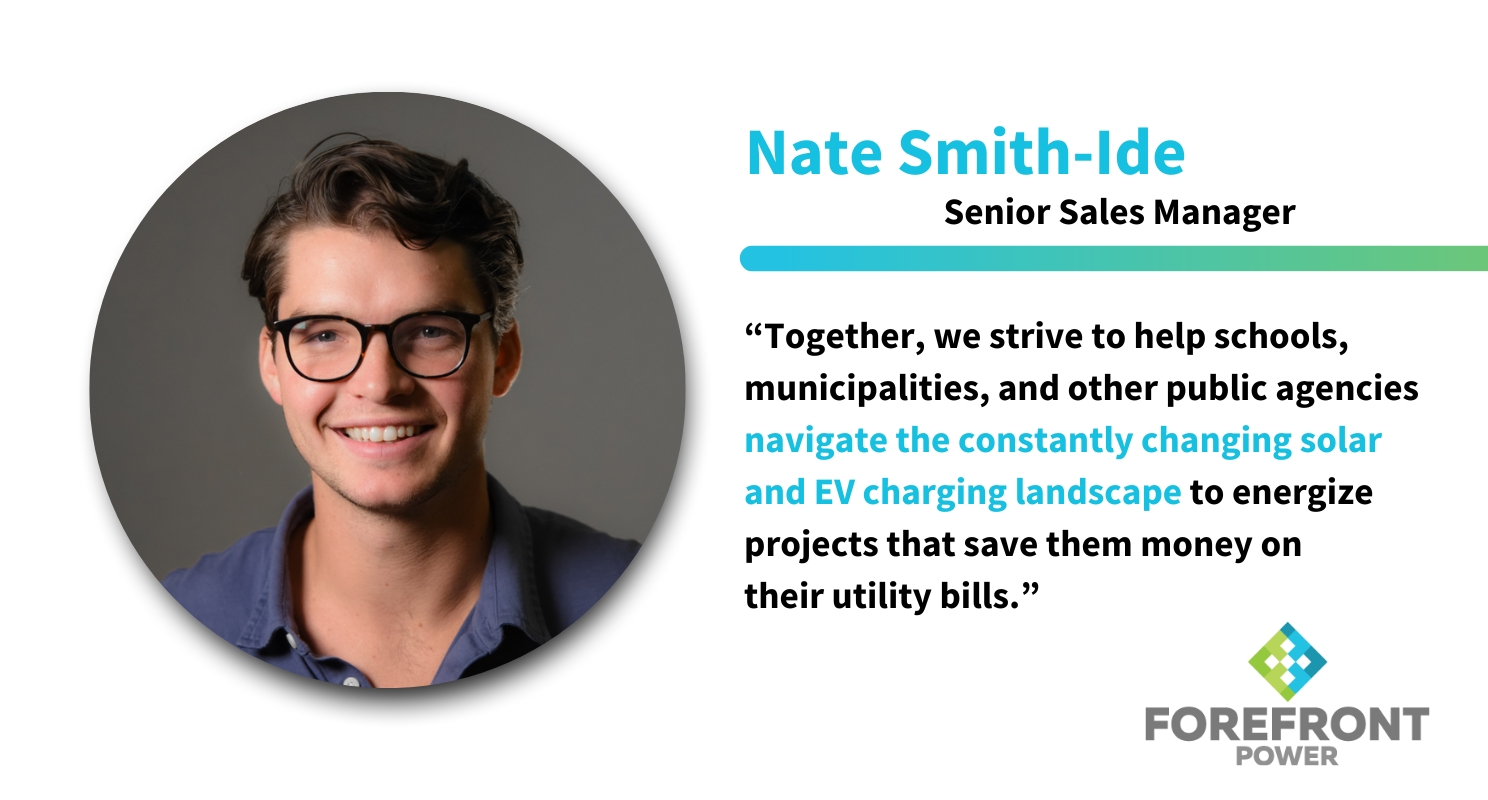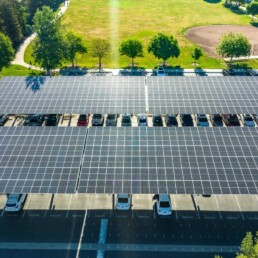We spoke to Senior Sales Manager Nate Smith-Ide ahead of his panel presentation at the CASH Annual Conference on School Facilities to learn more about his career journey and hear his thoughts on the state of fleet electrification.
Where are you from originally?
NSI: I grew up in an old steel town called Pottstown, Pennsylvania, about 45 minutes northwest of Philadelphia, where my parents are both teachers. I live in San Francisco now and have been here since graduating from undergrad in 2017.
What do you like to do in your free time?
NSI: I enjoy all the classically “unoriginal” California hobbies like skiing, surfing, biking, hiking, fishing. Anything that gets me outside. .
What did you want to be when you grew up?
NSI: All I knew was I wanted to be someone who was able to make a positive impact on humanity and the world around us. I think I was really influenced by my parents being teachers and constantly giving back to their students. Committing to the growth, development, and deployment of renewable energy has helped me work towards that goal.
What led you into the renewable energy field?
NSI: I actually majored in International and Global Studies, so I had no academic renewable energy experience. Going into my senior year of college, I was lucky enough to land an internship at a global NGO called Conservation International that works to protect and conserve the world’s most biodiverse areas and ecosystems of the world. I worked on the policy team, and it was a really impactful experience that inspired me to explore renewable energy as a potential career path.
How did you find ForeFront Power?
NSI: After graduating from school, I moved out to San Francisco and spent the first couple of months trying to network with whoever would talk to me. Luckily enough, one of those people worked at ForeFront Power. That person was kind enough to give me an interview, and I was eventually hired in the fall of 2017. Matt Grossman is actually still with ForeFront Power too, as our VP Market Development in Community Solar.
How has your role evolved during your time at ForeFront Power?
NSI: I began my career at ForeFront as a Sales Analyst doing everything on the back end of the sales process, from conducting pricing and savings analysis to understanding the design and engineering process of where solar projects can go and make the most sense. I worked as a sales analyst for the first year and a half before I was promoted to a more customer-facing role as a Sales Associate. That role was much more focused on outbound conversations, knocking on the proverbial customer door, and building the pipeline of potential sales opportunities. Then I was promoted to Sales Manager, which is similar to my current role, handling everything involved in the sales process from origination to contract execution and assisting the development team in the actual development of projects.
My role has evolved to where I’m now processing more opportunities. I’m working with the Sales Analysts who are kind enough to help me pursue as many opportunities for solar, storage, microgrid, and EV charging projects as possible. Together, we strive to enable renewable energy resources, predominantly in the California public sector, by helping schools, municipalities, and other public agencies navigate the constantly changing solar, storage, and EV charging landscape to energize projects that save them money on their utility bills.
What are some of the biggest challenges you face in your role, and how do you overcome them?
NSI: One of the most pervasive problems is cost changes in the marketplace. Constantly changing project inputs can be quite difficult to overcome as we’re trying to mitigate cost increases and offer the most valuable projects to our customers. Policy changes are also a big challenge. For example, the recent development with federally funded projects. Those funds that go into solar, storage, and EV charging projects have now been put into question. These policy changes are happening at the federal level down to a local level with evolving incentive opportunities from local air districts to the impending reduction of the self-generation incentive program (SGIP) for battery storage projects in California. The potential list of tariffs on solar and storage projects can be considerable headwinds for not only ForeFront Power, but the industry at large.
The most effective way of overcoming those challenges, especially the ones that are out of your control, is by having very transparent communication between the ForeFront Power team and our customers. Communicating actively about any sort of challenges enables dynamic collaboration, which is essential for overcoming these obstacles.
Do you have any favorite projects you’ve worked on so far?
NSI: I have a special place in my heart for the projects that I was fortunate enough to work on early on in my career. A few of those that come to mind would be the first project I worked on, the Cabrillo College solar portfolio in Aptos, California, just south of Santa Cruz and a 2024 finalist in Solar Builder’s Project of the Year Awards, and our solar and EV charging portfolio with Tracy Unified School District in Tracy, California. Those are two really meaningful projects to me, especially now that they are both up and running. Not only do the completed projects provide utility savings, but they also offer shaded parking and EV charging for the community, students and staff. I look back fondly on those projects.
How does solar energy support fleet electrification and EV charging infrastructure?
NSI: Solar energy is an excellent complement when there is enough space. It helps offset some of the additional utility costs that result from the higher energy demand from the EV charging stations. When we think specifically about K-12 fleet electrification, buses can charge between their morning and afternoon routes when the sun is at its highest. That’s coincident energy consumption load, meaning that it is coincident with the peak amount of energy production on a day-to-day basis from your solar project. That’s when solar projects do a great job of offsetting utility-related costs for K-12 fleet electrification projects.
What are your hopes for the current administration in terms of energy and infrastructure policy?
NSI: My hopes are that the administration continues to see value in the deployment of renewable energy infrastructure as a way of diversifying our current energy mix and reducing our collective carbon footprint. My personal philosophy on energy production and creation is that it requires a more nuanced approach and certainly a matrix of different energy resources. For example, in some places natural gas might work because there’s not enough space for a solar project or a wind project. Natural gas provides baseload power for many of our energy needs as a nation. Then there’s places like New York for geothermal, or Texas for wind. Our energy future will be reliant on a diverse base of energy resources.
I hope that the administration sees value in implementing long duration battery storage to maximize the impact of intermittent renewables as well as enhance overall grid resilience. Batteries do an excellent job of preventing significant grid strains when power is in high demand from a bunch of ratepayers. At the federal level, we should be thinking about how these projects can enable a more resilient and sustainable future.
What advice would you give to organizations considering renewable energy or fleet electrification?
NSI: Even with headwinds like potential tariffs or incentive changes, many of these projects are still able to provide value via avoided utility costs while advancing your renewable goals. On a bottom-line basis, they provide utility savings for folks and can help capture the full suite of available incentives for both renewable energy and EV charging projects, ranging from potential federal direct pay for non-taxpaying entities like schools pursuing renewable energy projects to local air quality management district incentive buckets for EV charging projects.
Do you have any advice for people who might want to enter the renewable energy field?
NSI: Renewable energy is such an evolving and dynamic space that it has opportunities for whatever someone may be interested in career-wise. From project finance and design/engineering to development and sales, renewable energy companies have vast teams with tons of industry expertise and technical nuance. That variability is what makes it a really fun space to be in. And ultimately, for me at least, it is gratifying to know that whatever you’re working on is providing a positive impact on the world around you. A career in this space is a great balance between working in a challenging, high-growth industry and continuing to strive towards the goal of doing good.
Interested in learning more?
We would love to discuss how our solutions might be a fit for your organization. Contact one of our solar, storage, or e-mobility experts today:








